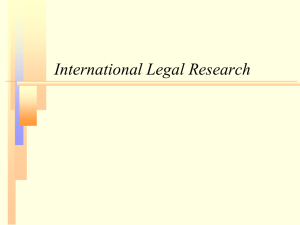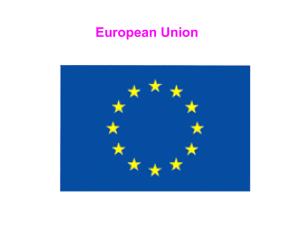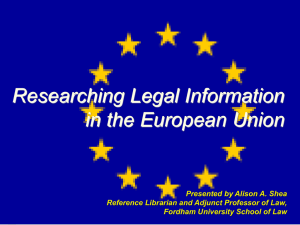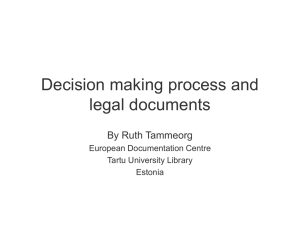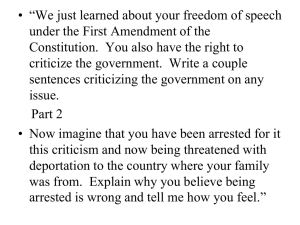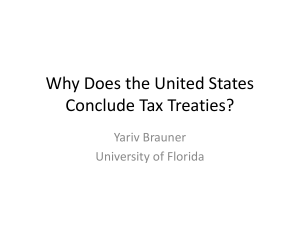Shea - PowerPoint - European Union
advertisement
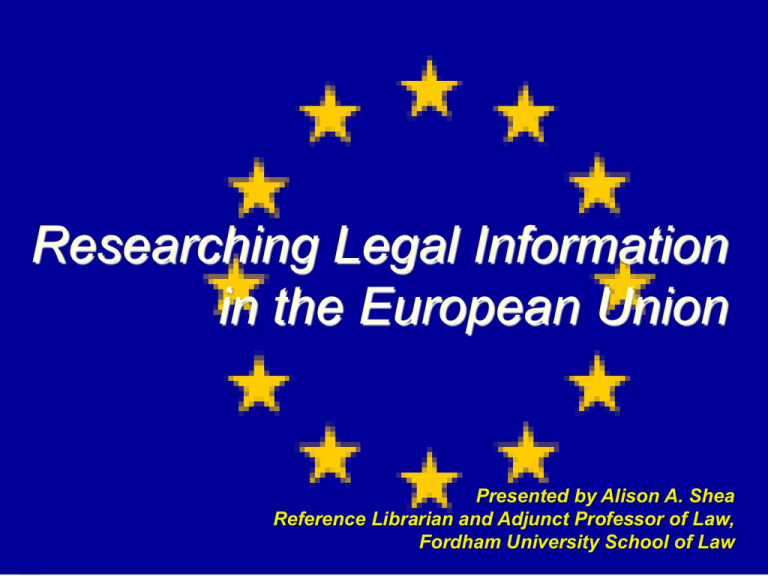
Researching Legal Information in the European Union Presented by Alison A. Shea Reference Librarian and Adjunct Professor of Law, Fordham University School of Law What is the European Union? A “unique economic and political partnership between 27 democratic European countries” Primarily created to avoid any future inter-Europe wars and to encourage more cross-border cooperation in commercial matters (“internal market”) What isn’t the European Union? Council of Europe European Court of Human Rights • “Do not get confused” chart (that’s the real name of the webpage!) – http://www.coe.int/aboutcoe/index.asp?page=n epasconfondre&l=en Hypo Does this agreement fall foul of EU law? Two leading low-cost carriers, Scaryair (based in Dublin) and Skeezyjet (based in the UK) currently have an estimated 35% of the market share of the total UK and Ireland domestic routes. Scaryair approach SkeezyJet about the possibility of coming to some sort of agreement whereby Scaryair would agree to drop some of its UK domestic routes that SkeezyJet also operates in return for SkeezyJet agreeing not to start a new service from UK-Ireland. Hierarchy of EU Law Treaties (Primary Legislation) Regulations, directives, decisions (Secondary Legislation) General Principles of Law Case Law Treaties between Member States Where to start? Europa – EU’s main info portal http://www.europa.eu Provides a gateway for locating EU information • Use this page to access various EU legal information portals • Search by Policy Area if you know what subject matter you’re looking for • Do a site-wide search if you’re not sure where to begin – Press releases are required to contain links to relevant docs LOCATING INFORMATION ON A TOPIC If you are starting from scratch, try browsing Policy Area for relevant links Search function is not very good, but remember that press If you have a citation, you can locate itreleases are now required to link to through the links under Legislation and primary source Treaties documents referred to, so they may be useful LOCATING INFORMATION ON A TOPIC Narrative descriptionLinks to relevant Links to relevant of the policy area—laws in this policy other sites, i.e. DG area for the “average Joe” Comp LOCATING INFORMATION ON A TOPIC LOCATING INFORMATION ON A TOPIC LOCATING INFORMATION ON A TOPIC LOCATING INFORMATION ON A TOPIC Example #1 I’m looking for legislation that deals with Bathing Water quality. I don’t have a cite, and don’t know how exactly it’s regulated or by whom. • When you are looking for general policy, try starting with Europa • Remember that press releases are now required to contain links to the relevant documents, so try searching the site • Also, you can browse the “Policy Areas” to try and locate the relevant DG for that topic From the main Europa page, you can either search the site for relevant hits, or browse through the policy areas to locate the relevant DG for this area At the bottom of the press release are links to the documents mentioned—which show that the relevant DG is Environment— and also the citations to the relevant legislation This is the relevant DG for bathing water quality—you can now browse for links to relevant legislation and other policy document Where do we find EU legal information? Primary legislation: Treaties Source of primary legislation Current treaties in force: • Consolidated Treaty on European Union (TEU) • Consolidated Treaty on the Functioning of the European Union (TFEU) • Charter of Fundamental Rights of the EU All treaties can be found here: • http://eurlex.europa.eu/JOHtml.do?uri=OJ:C:2010:0 83:SOM:EN:HTML Treaty of Lisbon What’s the big deal? • • • • Greater democracy and transparency Simplification and more efficient working Single voice on the international stage Promoting rights and values Key issues to watch will be what the EU does with increased power in foreign policy and justice, freedom and security Treaty of Lisbon Completely renumbers existing Treaty articles • ECJ recommends references to an article of the Treaty as it stood before 1 May 1999, the revised numbering should be given in brackets, e.g. ‘Article 85 of the EC Treaty (now Article 81 EC)’. • References to the Treaty as it stands after 1999 should read ‘Article 234 EC’. “Table of Equivalencies” for old and new article numbers available here: • 2010 OJ(C 83) 361 This page has not been updated!!!! Still lists Articles 8189 instead of 101109!! BB translation: 2010 O.J. (C 83) 88 Official Journal The OJ has been published since 1967 • two main series: – L (Legislation) – C (Communication = Information and Notices). • published daily in 22 of the 23 official languages. Available on Eur-Lex • You can now get PDFs back to 1973 in English, 1968 for original EC languages • “Certified” PDF version available—on the way to becoming “authentic” versions Example #3 Can I get a full text version of the following cite: 1990 O.J. (L 180) 26 • Since you already have the OJ cite, use Eur-Lex to search by OJ reference and simply fill in the relevant information: – Year: 1990 – OJ Series: L – OJ Number: 180 – Page: 26 To get the authentic fulltext scan of the original document, click on PDF Secondary Legislation Regulations • binding legal force throughout every Member State Directives • lay down certain end results that must be achieved in every Member State • national authorities have to adapt their laws to meet these goals, but are free to decide how to do so. • may concern one or more Member States, or all of them. Decisions • Binding in entirety but only to those Member States or entities to whom addressed Recommendations/Opinions • No binding force How to Find EU Legislation • Eur-Lex – Retrieve by citation if you have it already – Try using the Directory of Legislation in Force to browse through topical areas • Europa – Summary of EU Legislation in force • Through the relevant Commission group’s website – List of relevant DG sites: • http://ec.europa.eu/about/ds_en.htm • Lexis (EURCOM;LEGIS) • Westlaw (EU-LEG) Example #4 Locate Directive 2011/7/EU. What is it about? • Since you have the document number already, simply go to Eur-Lex and search by document number Is it published in an official source? • The Official Journal is the official source for all EU legislation Select PDF for official full text version Official full text version—to create cite, note data above: year 2011, journal series: L, journal volume 48, page 1. DIRECTORY OF EU LEGISLATION IN FORCE Use Directory of EU legislation in force when you wish to browse relevant law for a particular topic Each topic breaks down even further to more discrete topics; however results are listed in reverse chronological order, not in order of importance to that topic RETRIEVING LEGISLATION Easiest way to retrieve legislation by citation—by document number. You will still retrieve to the OJ version RETRIEVING LEGISLATION You can retrieve not only legislation but also preparatory docs, case law, and national execution measures by citation here RETRIEVING LEGISLATION Select Bibliographic notice for “annotations”—if this were a directive, always select this feature to locate national implementing legislation Select PDF for official full text version from OJ “ANNOTATIONS” Affected by case: Case law that litigates this particular piece of legislation CELEX numbers “6” stands for Sector 6, which is case law “ANNOTATIONS” Procedure = Legislative History Relationship between documents= where to find amendments Tracking EU legislation To track pending/proposed legislation (similar to Thomas in the US), use these sources which have the same information, just organized by two different groups • Pre-Lex – http://ec.europa.eu/prelex/apcnet.cfm?CL=en • Legislative Observatory – http://www.europarl.europa.eu/oeil/index.jsp?la nguage=en European Commission – COM docs The EC is the only body who can propose legislation, and they do this in the form of a COM document There is usually a lengthy period of consultation and amendment before COM Documents become public, and only the final version is published. Consequently, they are cited in the format: • COM (year) running number, final Where to find EC documents Registry of Commission Documents Pre-Lex or Legislative Observatory Eur-Lex • All of the above sources allow for retrieval by citation If you do not know what you are looking for but prefer to browse, try the Commission page for the policy area COM Docs through PRE-LEX COM Docs through PRE-LEX Almost exactly the same information as presented on Legislative Observatory, just a different format (more colorful?) Court of Justice of the European Union Three main competencies: • reviews the legality of the acts of the institutions of the European Union, • ensures that the Member States comply with obligations under the Treaties, and • interprets European Union law at the request of the national courts and tribunals Consists of three courts: • the Court of Justice • the General Court (created in 1988) • the Civil Service Tribunal (created in 2004). Where to find EU cases & decisions Eur-Lex • http://eur-lex.europa.eu/RECH_jurisprudence.do Curia • http://curia.europa.eu/\ European Court Reports (E.C.R.) [official] • Part I contains the ECJ cases and AdvocateGeneral Opinions • Part II contains the CFI/GC cases. • Traditionally only print…. – HOWEVER….they are working to link PDFs of ECR decisions to all cases from 1992—will say “PDF” in the bibliographic record if available. Also EU Bookshop now has incomplete coverage PDFs of the ECR going back to 2005 on its website SEARCHING EUR-LEX FOR CASE LAW Instead, try simple search to search by word, date, party name, etc. “Case law” is not very useful—just brings you to a browse-by-date screen SEARCHING EUR-LEX FOR CASE LAW Select “search terms” to full text search You can browse all cases in certain topic areas by selecting “Subject matter” “Digest of case-law” is not as useful as it seems--only really good to browse by legal basis of case SEARCHING EUR-LEX FOR CASE LAW When searching Eur-Lex remember to distinguish what you want to search— default search is only to Titles and subject heading SEARCHING EUR-LEX FOR CASE LAW Example #4 “Would you please send me the ECJ judgment in Kanal 5 (2008). Thanks.” • When looking for a case, try starting with Curia, the European Courts’ official website. You can also search case law using Eur-Lex Is there an official version available? • Eur-Lex provides ECR citations, but there is no electronic version of the ECR version as of yet Curia’s simple search box on the front page makes it easy to locate cases using basic data—in this instance, we know the name of the party (Kanal 5—but only input “Kanal” incase the decision spells out the number), the court (Court of Justice), and the date (2008, although with the distinctive party name we probably don’t even need the date) Be sure you are aware of which result is the one that you want—for example, the OJ cite “looks” official but is only a summary of the judgement, not the actual full text. Also, be aware of the difference between the judgment and the Advocate Generals’ Opinion (which preceeds the actual judgment) Unofficial (but reliable) full text of the judgement Now that you have the case number (C-52/07) you can easily retrieve the case through EurLex; it will not give you the official version, but will give you the cite to the official reporter This is the official reporter citation---2008 ECR I-9275 SEARCHING FOR CASE LAW BY TOPIC To access advanced search features, click on the tiny graphic with the magnifying glass SEARCHING FOR CASE LAW BY TOPIC Under the “Field” heading, select the relevant topic and adjust other field (type of document, Court, date, etc) SEARCHING FOR CASE LAW BY TOPIC All cases for that topic GOING BACK TO 1997-not a complete reflection of EU case law on a topic Dockets There are NO procedural documents available for EU case law; if you want them, you must apply to the Registry and even then they might not release them, especially if you are not an EU citizen Advocate General opinions The advocates general assist the Court in its task. • They deliver, in open court and with complete impartiality and independence, opinions on the cases brought before the Court. • duties should not be confused with those of a prosecutor or similar official--that is the role of the Commission, as guardian of the Community’s interests Use Curia to search for AG opinions SEARCHING ADVOCATEGENERAL OPINIONS Be sure you are aware of which result is the one that you want—for example, the OJ cite “looks” official but is only a summary of the judgment, not the actual full text. Also, be aware of the difference between the judgment and the Advocate Generals’ Opinion (which precedes the actual judgment) Example #5 Could you give me a list of all EU cases that deal with free movement of goods that have been decided in the past year? • You can easily search cases by topic using Curia To access advanced search features, click on the tiny graphic with the magnifying glass Under the “Field” heading, select the relevant topic Limit your dates and, if you want, limit the type of documents that will be returned so as to weed out any unnecessary hits Special note about competition cases Competition law cases start as commission investigations, which result in a decision • Similar to US FTC decision The DG Comp has a great database for searching commission decisions taken in the areas of: • • • • Antitrust Cartels Mergers State Aid Many decisions also available through Eur-Lex but much better interface and organization on DG Comp page SEARCHING COMPETITION CASES SEARCHING COMPETITION CASES SEARCHING COMPETITION CASES Commonly cited as: Case COMP/39.596 Are we finished? Primary Article 101 of the TFEU Secondary Regulation 1/2003 Case law European Court cases Commission decisions Preparatory DOMESTIC LAW! Researching domestic law Each Member State will have its own domestic laws on any topic and will need to be referenced together with EU law • Use traditional foreign legal research methods to locate EU laws • If you are referencing a Directive, use the National Implementing legislation link within the bibliographic record • Try using N-lex, especially if you are unfamiliar with the Member State’s language Researching domestic law There is an excellent resource called EuroVoc which is a multilingual, multidisciplinary thesaurus covering the activities of the EU, the European Parliament in particular. • Allows users to search domestic law throughout all EU countries without having to know the native language • contains terms in 22 EU languages (Bulgarian, Czech, Danish, Dutch, English, Estonian, Finnish, French, German, Greek, Hungarian, Italian, Latvian, Lithuanian, Maltese, Polish, Portuguese, Romanian, Slovak, Slovenian, Spanish and Swedish), plus Croatian and Serbian.
